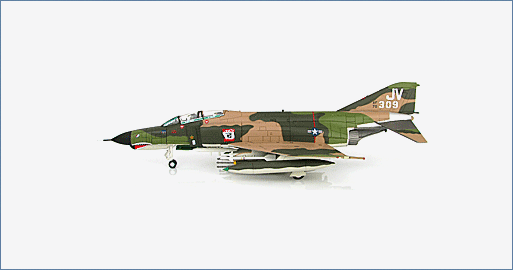Air Power Series>1:72 die-cast display model>F-4>HA1989
F-4E Phantom II "EL TORO BRAVO" 469th TFS, 388th TFW, Korat RTAFB, 1960s

General Background
The F-4D was an improved “C” variant with most improvements being internal electronics and
avionics. The F-4D entered operational service in April 1966 and joined the combat forces in
Southeast Asia in May 1967. With the arrival of the “D” most of the “C” variant
was reassigned to ground attack with the “D”s taking on the air-to-air interceptor role. In 1968 –
1969 a total of 825 “D” models were produced 793 for the USAF and 32 for the Iranian Air Force.
The Aircraft
In mid-1968 the 388th TFW stationed at Korat, RTAFB transitioned from the Republic F-105
Thunderchief to the McDonnell Douglas F-4E. F-4E 67-0309 wears a red star on the engine
splitter signifying a MiG kill but it was never a confirmed victory since there was a ceasefire in
place. From the 469th TFS/388th TFW the aircraft moved to the 15th TFW and then on to the
94th TFS/1st TFW. Eventually after a complete of other moves the aircraft was sold to the
Egyptian AF in 1980 as 7828.
Specifications :
| The RF-4E variant was an unarmed reconnaissance version for export only. Retrofitted to carry weapons by most customers. | |
| Engines: | (2) General Electric J79-GE-17 turbojets. |
| Thrust: | 11,870 lb. st dry, 17,900 lb. st with afterburners. |
| Dimensions | |
| Length: | 63 ft 0 in |
| Height: | 16 ft 6 in |
| Wingspan: | 38 ft 5 in |
| Wingarea: | 530 sq ft |
| Performance |
|
| Cruise Speed: | 585 mph |
| Max Speed: | 1,430 mph at 36,000 ft (Mach 2.21) |
| 914 mph at sea level (Mach 1.19) | |
| Landing speed: | 158 mph |
| Initial rate of climb: | 61,400 fpm |
| Service Ceiling: | 62,250 ft |
| Combat Ceiling: | 59,600 ft |
| Combat range: | 595 miles |
| Maximum range: | 1885 miles with maximum external fuel |
| Armament: | (1) 20-mm M61A1 cannon with 639 rounds in an under-nose gondola |
| (4) AIM-7 Sparrow semi-active radar homing air-to-air missiles in semi-recessed slots in the fuselage belly. | |
| (2) to (4) AIM-9 Sidewinder infra-red homing air-to-air missiles carried under the wings on the inboard pylons. | |
| Total offensive load of up to 16,000 pounds could be carried on the centerline and four under- wing hard-points. | |

